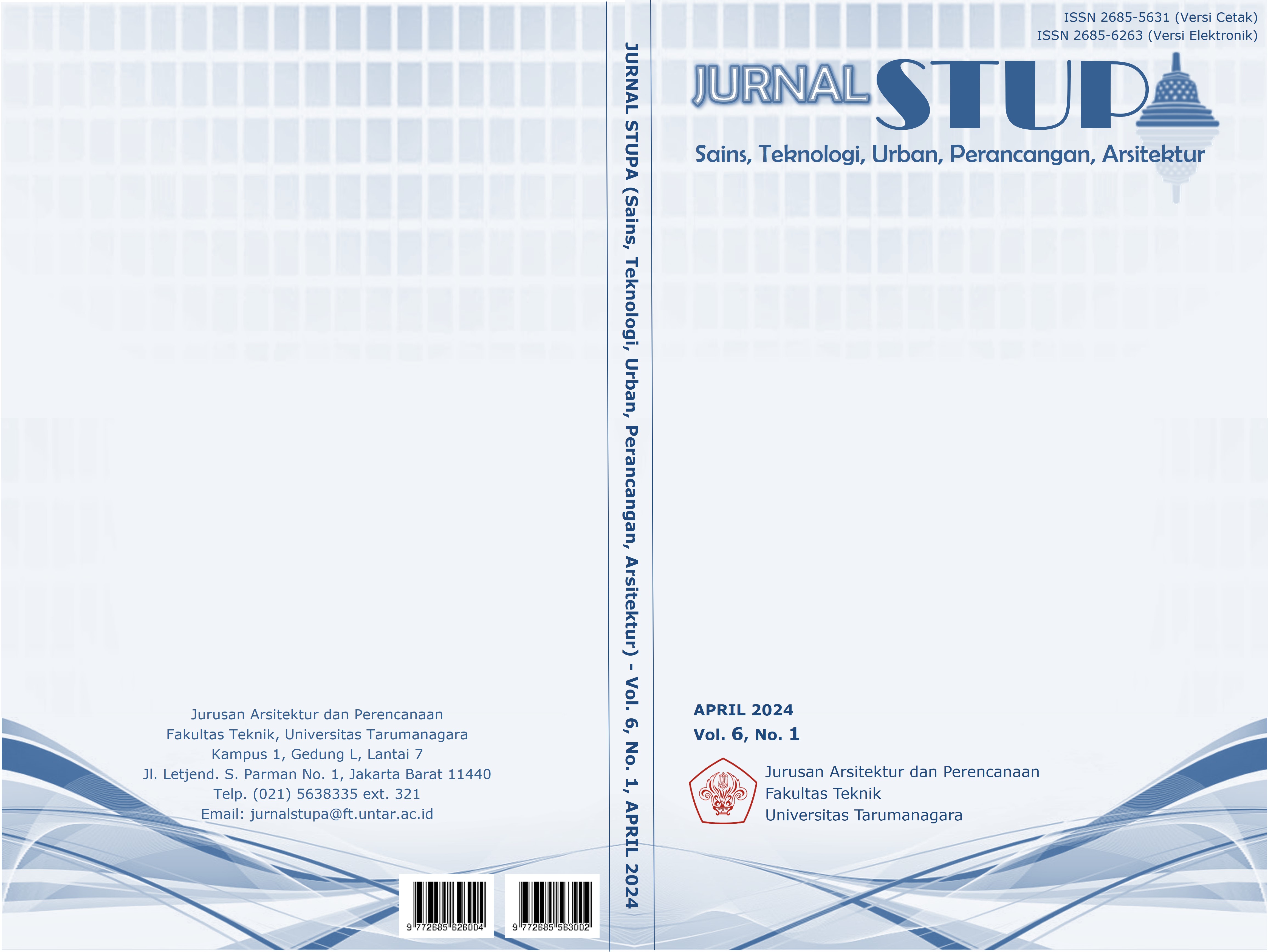PENDEKATAN EMPATI-SALUTOGENIK DALAM PERANCANGAN FASILITAS PERAWATAN MASA NIFAS
Main Article Content
Abstract
Postnatal care centers play an important role in facilitating a woman's physical and emotional recovery after giving birth. This journal discusses the integration of salutogenic and empathetic design principles within postnatal care centers, with the goal of providing an environment that comprehensively nurtures the health and well-being of postnatal mothers. Salutogenic design focuses on promoting health and resilience, while empathic design centers on recognizing and addressing individual needs. This paper explores the fundamental aspects of salutogenic design, including personalized spaces, exposure to natural light, access to natural elements, acoustic comfort and the integration of positive distractions. In addition, this journal emphasizes the importance of clear spatial organization and the provision of privacy within postnatal care centers to pay attention to psychological aspects. Simultaneously, empathetic design considerations involve creating spaces that support mothers' emotional well-being during the postpartum period that is vulnerable to physical and emotional instability. Incorporating these design principles within a postnatal care center can produce a therapeutic environment that not only supports physical recovery but also maintains emotional resilience. The research uses qualitative methods to look for relationships and impacts that can be produced by the application of salutogenics in the design process. The journal aims to provide application and determine the impact of implementing empathetic and salutogenic aspects into the design of postpartum facilities such as the integration of green areas, customized programs for the mother's physical and mental recovery, as well as customized units based on needs.
Keywords: Empathic; Post partum; Salutogenic
Abstrak
Pusat perawatan masa nifas memegang peran penting dalam memfasilitasi pemulihan fisik dan emosional wanita setelah melahirkan. Jurnal ini membahas integrasi prinsip-prinsip desain salutogenik dan empatik di dalam pusat perawatan pasca melahirkan, dengan tujuan menyediakan lingkungan yang secara komprehensif memelihara kesehatan dan kesejahteraan para ibu pasca melahirkan. Desain salutogenik berfokus pada promosi kesehatan dan ketahanan, sementara desain empatik berpusat pada pengenalan dan penanganan kebutuhan individu. Makalah ini mengeksplorasi aspek mendasar desain salutogenik, mencakup ruang yang dipersonalisasikan seesuai kebutuhan, paparan cahaya alami, akses ke elemen alami, kenyamanan akustik, dan integrasi distraksi positif. Selain itu, jurnal ini menekankan pentingnya organisasi spasial yang jelas dan penyediaan privasi di dalam pusat perawatan masa nifas untuk memperhatikan aspek psikologis. Secara bersamaan, pertimbangan desain empatik melibatkan penciptaan ruang yang mendukung kesejahteraan emosional para ibu selama masa nifas yang rentan akan ketidakstabilan fisik dan emosional. Penggabungan prinsip-prinsip desain ini di dalam pusat perawatan pasca melahirkan dapat menghasilkan lingkungan terapeutik yang tidak hanya mendukung pemulihan fisik tetapi juga memelihara ketahanan emosional. Penelitian menggunakan metode kualitatif untuk mencari hubungan dan dampak yang dapat dihasilkan oleh penerapan salutogenik dalam proses perancangan. Jurnal bertujuan untuk memberikan penerapan dan mengetahui dampak penerapan aspek empati dan salutogenik kedalam desain fasilitas masa nifas seperti integrasi area hijau, program yang disesuaikan untuk pemulihan fisik dan mental ibu, serta unit yang terkostumisasi berdasarkan kebutuhan.
Article Details

This work is licensed under a Creative Commons Attribution-NonCommercial-ShareAlike 4.0 International License.
This work is licensed under a Jurnal Sains, Teknologi, Urban, Perancangan, Arsitektur/ STUPA Creative Commons Attribution-NonCommercial-ShareAlike 4.0 International LicenseReferences
Abdullah, F., Yusoff, L., Abd Razak, M. R., Yusof, Z. B., & Azmin, A. K. (2021). Analysis Of Spatial Requirement For Confinement Centre To Support The Needs Of Women With Postpartum Depression. Journal of Architecture, Planning and Construction Management, 11(2).
Antonovsky, A. (1979). Health, stress, and coping. Jossey-Bass.
Golembiewski, J. (2022). Salutogenic Architecture. The Handbook of Salutogenesis, 259-274.
Hsu, T., Ryherd, E., Persson Waye, K., & Ackerman, J. (2012). Noise Pollution in Hospitals: Impact on Patients. Journal of Clinical Outcomes Management, 19(7), 301-309.
Huisman,, E.R.C.M. & Morales,, E. & Hoof,, J. & Kort, Helianthe. (2012). Healing environment: A review of the impact of physical environmental factors on users. Building and Environment, 58, 70 - 80.
Mittelmark, M.B., and Bauer, G.F. (2017). The Meanings of Salutogenesis. The Handbook of Salutogenesis, 7-13.
Padmakumar, A. D., Bhasin, V., Wenham, T. N., & Bodenham, A. R. (2013). Evaluation of Noise Levels in Intensive Care Units in Two Large Teaching Hospitals – A Prospective Observational Study. Journal of the Intensive Care Society, 14(3), 205-210.
Ulrich, R. S., Bogren, L., Gardiner, S. K., & Lundin, S. (2018). Psychiatric ward design can reduce aggressive behaviour. Journal of Environmental Psychology, 57, 53–66.
Wahyuni, E. D. (2018). Asuhan Kebidanan Nifas dan Menyusui. In Kementrian Kesehatan Republik Indonesia (1st ed.). http://bppsdmk.kemkes.go.id/pusdiksdmk/wpcontent/uploads/2018/09/Asuhan-Kebidanan-Nifas-dan-Menyusui_SC.pdf
Wang J, Wei Z, Yao N, Li C, Sun L. (1998). Association Between Sunlight Exposure and Mental Health: Evidence from a Special Population Without Sunlight in Work. Risk management and healthcare policy. 1049-1057.
World Health Organization. Maternal and Newborn Health/Safe Motherhood Unit.
World Health Organization. (2010). WHO Technical Consultation on Postpartum and Postnatal Care. Retrieved from https://apps.who.int/iris/handle/10665/7043
Zetterquist, A. (2009). Healing environments: Elements of retreat (Master's thesis), Montana State University, Bozeman, Montana. Retrieved from 16th August 2020 https://scholarworks.montana.edu/xmlui/bitstream/handle/1/2596/ZetterquistA0509.pdf?se quence



